Namibia
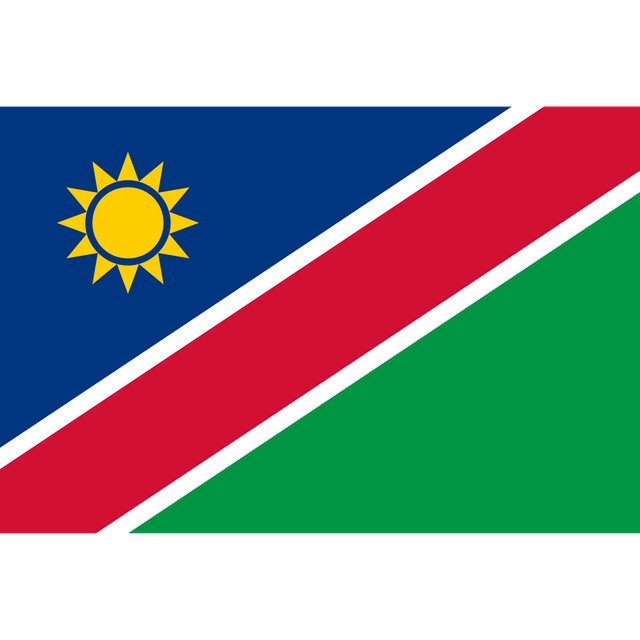
Namibia

Republic of Namibia | |
|---|---|
Motto:"Unity, Liberty, Justice" | |
Anthem:"Namibia, Land of the Brave" | |
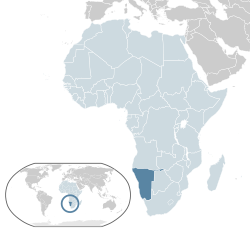 Location of Namibia (Dark Blue) in the African Union (Light Blue) | |
| Capital and largest city | Windhoek 22°34′S 17°5′E [191] |
| Official languages | English |
| Recognised national languages | |
| Recognised regional languages |
|
| Ethnic groups (2014) |
|
| Demonym(s) | Namibian |
| Government | Unitary dominant-party semi-presidential republic[9][10] |
• President | Hage Geingob |
• Vice President | Nangolo Mbumba |
• Prime Minister | Saara Kuugongelwa-Amadhila |
• Deputy Prime Minister | Netumbo Nandi-Ndaitwah |
| Legislature | Parliament |
• Upper house | National Council |
• Lower house | National Assembly |
| Independence from South Africa | |
• Constitution | 09 February 1990 |
• Independence | 21 March 1990 |
| Area | |
• Total | 825,615 km2(318,772 sq mi) (34th) |
• Water (%) | negligible |
| Population | |
• 2017 estimate | 2,606,971[11] |
• Density | 3.2/km2(8.3/sq mi) (235th) |
| GDP(PPP) | 2018 estimate |
• Total | $27.505 billion[12] |
• Per capita | $11,516[12] |
| GDP(nominal) | 2018 estimate |
• Total | $14.148 billion[12] |
• Per capita | $5,923[12] |
| Gini(2015) | 59.1[13] high |
| HDI(2017) | medium · 129th |
| Currency | Namibian dollar (NAD) South African rand (ZAR) |
| Time zone | UTC+2(CAST) |
| Driving side | left |
| Calling code | +264 |
| ISO 3166 code | NA |
| Internet TLD | .na |
Namibia (/nəˈmɪbiə/ (listen), /næˈ-/),[15][16] officially the Republic of Namibia, is a country in southern Africa. Its western border is the Atlantic Ocean; it shares land borders with Zambia and Angola to the north, Botswana to the east and South Africa to the south and east. Although it does not border Zimbabwe, less than 200 metres of the Zambezi River separates the two countries. Namibia gained independence from South Africa on 21 March 1990, following the Namibian War of Independence. Its capital and largest city is Windhoek, and it is a member state of the United Nations (UN), the Southern African Development Community (SADC), the African Union (AU), and the Commonwealth of Nations.
Namibia, the driest country in Sub-Saharan Africa,[17] was inhabited since early times by the San, Damara and Nama people. Around the 14th century, immigrating Bantu peoples arrived as part of the Bantu expansion. Since then, the Bantu groups, the largest being the Aawambo, have dominated the population of the country; since the late 19th century, they have constituted a majority.
In 1878, the Cape of Good Hope, then a British colony, annexed the port of Walvis Bay and the offshore Penguin Islands; these became an integral part of the new Union of South Africa at its creation in 1910. In 1884 the German Empire established rule over most of the territory, forming a colony known as German South West Africa. It developed farming and infrastructure. Between 1904 and 1908 it perpetrated a genocide against the Herero and Nama people. German rule ended in 1915 with a defeat by South African forces. In 1920, after the end of World War I, the League of Nations mandated the administration of the colony to South Africa. It imposed its laws, including racial classifications and rules. From 1948, with the National Party elected to power, South Africa applied apartheid also to what was then known as South West Africa.
In the later 20th century, uprisings and demands for political representation by native African political activists seeking independence resulted in the UN assuming direct responsibility over the territory in 1966, but South Africa maintained de facto rule. In 1973 the UN recognised the South West Africa People's Organisation (SWAPO) as the official representative of the Namibian people; the party is dominated by the Aawambo, who are a large plurality in the territory. Following continued guerrilla warfare, South Africa installed an interim administration in Namibia in 1985. Namibia obtained full independence from South Africa in 1990. However, Walvis Bay and the Penguin Islands remained under South African control until 1994.
Namibia has a population of 2.6 million people and a stable multi-party parliamentary democracy. Agriculture, herding, tourism and the mining industry – including mining for gem diamonds, uranium, gold, silver, and base metals – form the basis of its economy. The large, arid Namib Desert has resulted in Namibia being overall one of the least densely populated countries in the world.
Republic of Namibia | |
|---|---|
Motto:"Unity, Liberty, Justice" | |
Anthem:"Namibia, Land of the Brave" | |
 Location of Namibia (Dark Blue) in the African Union (Light Blue) | |
| Capital and largest city | Windhoek 22°34′S 17°5′E [191] |
| Official languages | English |
| Recognised national languages | |
| Recognised regional languages |
|
| Ethnic groups (2014) |
|
| Demonym(s) | Namibian |
| Government | Unitary dominant-party semi-presidential republic[9][10] |
• President | Hage Geingob |
• Vice President | Nangolo Mbumba |
• Prime Minister | Saara Kuugongelwa-Amadhila |
• Deputy Prime Minister | Netumbo Nandi-Ndaitwah |
| Legislature | Parliament |
• Upper house | National Council |
• Lower house | National Assembly |
| Independence from South Africa | |
• Constitution | 09 February 1990 |
• Independence | 21 March 1990 |
| Area | |
• Total | 825,615 km2(318,772 sq mi) (34th) |
• Water (%) | negligible |
| Population | |
• 2017 estimate | 2,606,971[11] |
• Density | 3.2/km2(8.3/sq mi) (235th) |
| GDP(PPP) | 2018 estimate |
• Total | $27.505 billion[12] |
• Per capita | $11,516[12] |
| GDP(nominal) | 2018 estimate |
• Total | $14.148 billion[12] |
• Per capita | $5,923[12] |
| Gini(2015) | 59.1[13] high |
| HDI(2017) | medium · 129th |
| Currency | Namibian dollar (NAD) South African rand (ZAR) |
| Time zone | UTC+2(CAST) |
| Driving side | left |
| Calling code | +264 |
| ISO 3166 code | NA |
| Internet TLD | .na |
Etymology
The name of the country is derived from the Namib Desert, considered to be the oldest desert in the world.[18] The name Namib itself is of Nama origin and means "vast place". Before its independence in 1990, the area was known first as German South-West Africa (Deutsch-Südwestafrika), then as South-West Africa, reflecting the colonial occupation by the Germans and the South Africans (technically on behalf of the British crown reflecting South Africa's dominion status within the British Empire).
History
Pre-colonial period

San people are Namibia's oldest indigenous inhabitants.
The dry lands of Namibia have been inhabited since early times by San, Damara, and Nama. Around the 14th century, immigrating Bantu people began to arrive during the Bantu expansion from central Africa.
From the late 18th century onward, Oorlam people from Cape Colony crossed the Orange River and moved into the area that today is southern Namibia.[19] Their encounters with the nomadic Nama tribes were largely peaceful. They received the missionaries accompanying the Oorlam very well,[20] granting them the right to use waterholes and grazing against an annual payment.[21] On their way further north, however, the Oorlam encountered clans of the OvaHerero at Windhoek, Gobabis, and Okahandja, who resisted their encroachment. The Nama-Herero War broke out in 1880, with hostilities ebbing only after the German Empire deployed troops to the contested places and cemented the status quo among the Nama, Oorlam, and Herero.[22]
The first Europeans to disembark and explore the region were the Portuguese navigators Diogo Cão in 1485 and Bartolomeu Dias in 1486, but the Portuguese did not try to claim the area. Like most of interior Sub-Saharan Africa, Namibia was not extensively explored by Europeans until the 19th century. At that time traders and settlers came principally from Germany and Sweden. In the late 19th century, Dorsland Trekkers crossed the area on their way from the Transvaal to Angola. Some of them settled in Namibia instead of continuing their journey.
German rule
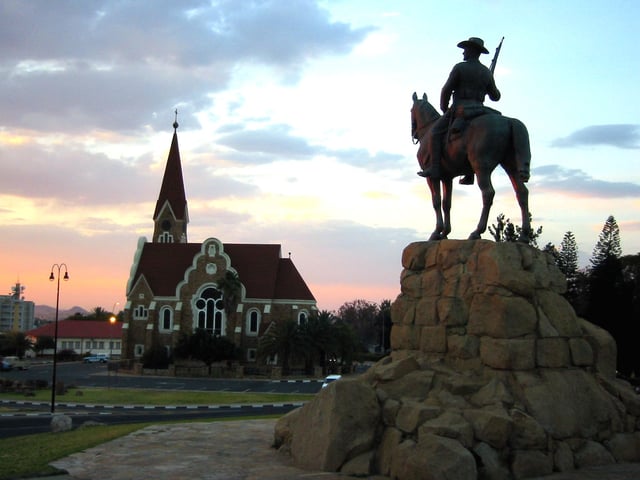
German church and monument to colonists in Windhoek, Namibia.
Namibia became a German colony in 1884 under Otto von Bismarck to forestall perceived British encroachment and was known as German South West Africa (Deutsch-Südwestafrika).[23] The Palgrave Commission by the British governor in Cape Town determined that only the natural deep-water harbour of Walvis Bay was worth occupying and thus annexed it to the Cape province of British South Africa.
From 1904 to 1907, the Herero and the Namaqua took up arms against brutal German colonialism. In calculated punitive action by the German occupiers, government officials ordered extinction of the natives in the OvaHerero and Namaqua genocide. In what has been called the "first genocide of the 20th century",[24] the Germans systematically killed 10,000 Nama (half the population) and approximately 65,000 Herero (about 80% of the population).[25][26] The survivors, when finally released from detention, were subjected to a policy of dispossession, deportation, forced labour, racial segregation, and discrimination in a system that in many ways anticipated the apartheid established by South Africa in 1948.
Most Africans were confined to so-called native territories, which under South African rule after 1949 were turned into "homelands" (Bantustans). Some historians have speculated that the German genocide in Namibia was a model for the Nazis in the Holocaust.[27] The memory of genocide remains relevant to ethnic identity in independent Namibia and to relations with Germany.[28] The German government formally apologized for the Namibian genocide in 2004.[29]
South African mandate
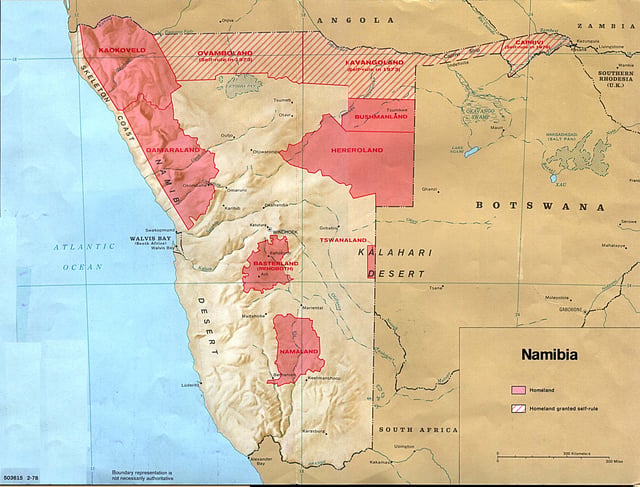
Map depicting the Police Zone (in tan) and tribal homelands (in red) as they existed in 1978. Self-governing tribal homelands appear as tan with red stripes.

Foreign Observer identification badge issued during the 1989 Namibian election
During World War I, South African troops under General Louis Botha occupied the territory and deposed the German colonial administration. The end of the war and the Treaty of Versailles left South Africa in possession of South West Africa as a League of Nations mandate.[30] The mandate system was formed as a compromise between those who advocated for an Allied annexation of former German and Turkish territories and a proposition put forward by those who wished to grant them to an international trusteeship until they could govern themselves.[30] It permitted the South African government to administer South West Africa until that territory's inhabitants were prepared for political self-determination.[31] South Africa interpreted the mandate as a veiled annexation and made no attempt to prepare South West Africa for future autonomy.[31]
As a result of the Conference on International Organization in 1945, the League of Nations was formally superseded by the United Nations (UN) and former League mandates by a trusteeship system. Article 77 of the United Nations Charter stated that UN trusteeship "shall apply...to territories now held under mandate"; furthermore, it would "be a matter of subsequent agreement as to which territories in the foregoing territories will be brought under the trusteeship system and under what terms".[32] The UN requested all former League of Nations mandates be surrendered to its Trusteeship Council in anticipation of their independence.[32] South Africa declined to do so and instead requested permission from the UN to formally annex South West Africa, for which it received considerable criticism.[32] When the UN General Assembly rejected this proposal, South Africa dismissed its opinion and began solidifying control of the territory.[32] The UN responded by deferring to the International Court of Justice (ICJ), which held a number of discussions on the legality of South African rule between 1949 and 1966.[33]
South Africa began imposing apartheid, its codified system of racial segregation and discrimination, on South West Africa during the late 1940s.[34] Black South West Africans were subject to pass laws, curfews, and a host of draconian residential regulations that heavily restricted their movement. Development was concentrated in the region of the country immediately adjacent to South Africa, formally called the "Police Zone", where most of the German colonial era settlements and mines were. Outside the Police Zone, indigenous peoples were restricted to theoretically self-governing tribal homelands.[35]
During the late 1950s and early 1960s, pressure for global decolonisation and national self-determination began mounting on the African continent; these factors had a radical impact on South West African nationalism. Early nationalist organisations such as the South West African National Union (SWANU) and South West African People's Organisation (SWAPO) made determined attempts to establish indigenous political structures for an independent South West Africa.[36] In 1966, following the ICJ's controversial ruling that it had no legal standing to consider the question of South African rule, SWAPO launched an armed insurgency that escalated into part of a wider regional conflict known as the South African Border War.[37]
Independence
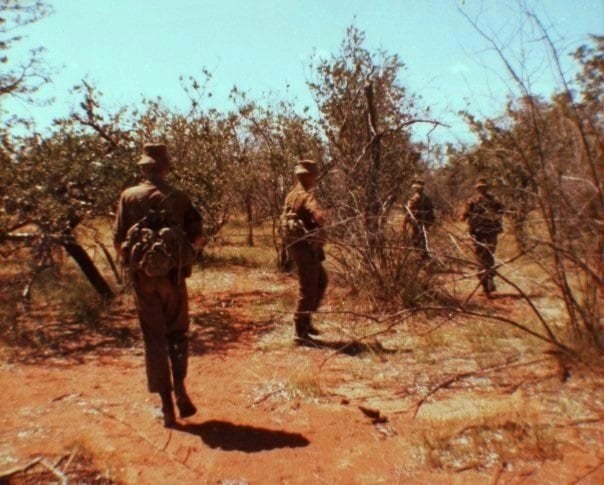
South African troops patrol the border region for PLAN insurgents, 1980s.
As SWAPO's insurgency intensified, South Africa's case for annexation in the international community continued to decline.[38] The UN declared that South Africa had failed in its obligations to ensure the moral and material well-being of South West Africa's indigenous inhabitants and had thus disavowed its own mandate.[39] On 12 June 1968, the UN General Assembly adopted a resolution proclaiming that, in accordance with the desires of its people, South West Africa be renamed Namibia.[39] United Nations Security Council Resolution 269, adopted in August 1969, declared South Africa's continued occupation of Namibia illegal.[39][40] In recognition of this landmark decision, SWAPO's armed wing was renamed the People's Liberation Army of Namibia (PLAN).[41]
Namibia became one of several flashpoints for Cold War proxy conflicts in southern Africa during the latter years of the PLAN insurgency.[42] The insurgents sought out weapons and sent recruits to the Soviet Union for military training.[43] SWAPO's political leadership, dependent on military aid from the Soviets, Cuba, and Angola, positioned the movement within the socialist bloc by 1975.[44] This practical alliance reinforced the prevailing perspective of SWAPO as a Soviet proxy, which dominated Cold War ideology in South Africa and the United States.[35] For its part, the Soviet Union supported SWAPO partly because it viewed South Africa as a regional Western ally.[45]
Growing war weariness and the reduction of tensions between the superpowers compelled South Africa, Angola, and Cuba to accede to the Tripartite Accord, under pressure from both the Soviet Union and the United States.[46] South Africa accepted Namibian independence in exchange for Cuban military withdrawal from the region and an Angolan commitment to cease all aid to PLAN.[47] PLAN and South Africa adopted an informal ceasefire in August 1988, and a United Nations Transition Assistance Group (UNTAG) was formed to monitor the Namibian peace process and supervise the return of refugees.[48] The ceasefire was broken after PLAN made a final incursion into the territory, possibly as a result of misunderstanding UNTAG's directives, in March 1989.[49] A new ceasefire was later imposed with the condition that the insurgents were to be confined to their external bases in Angola until they could be disarmed and demobilised by UNTAG.[48][50]
By the end of the 11-month transition period, the last South African troops had been withdrawn from Namibia, all political prisoners granted amnesty, racially discriminatory legislation repealed, and 42,000 Namibian refugees returned to their homes. Just over 97% of eligible voters participated in the country's first parliamentary elections held under a universal franchise.[51] The United Nations plan included oversight by foreign election observers in an effort to ensure a free and fair election. SWAPO won a plurality of seats in the Constituent Assembly with 57% of the popular vote.[51] This gave the party 41 seats, but not a two-thirds majority, which would have enabled it to draft the constitution on its own.[51]
The Namibian Constitution was adopted in February 1990. It incorporated protection for human rights and compensation for state expropriations of private property, and established an independent judiciary, legislature, and an executive presidency (the constituent assembly became the national assembly). The country officially became independent on 21 March 1990. Sam Nujoma was sworn in as the first President of Namibia at a ceremony attended by Nelson Mandela of South Africa (who had been released from prison the previous month) and representatives from 147 countries, including 20 heads of state.[52] Upon the end of Apartheid in South Africa in 1994, the nation ceded Walvis Bay to Namibia.[53]
After independence
Since independence Namibia has completed the transition from white minority apartheid rule to parliamentary democracy. Multiparty democracy was introduced and has been maintained, with local, regional and national elections held regularly. Several registered political parties are active and represented in the National Assembly, although the SWAPO has won every election since independence.[54] The transition from the 15-year rule of President Nujoma to his successor Hifikepunye Pohamba in 2005 went smoothly.[55]
Since independence, the Namibian government has promoted a policy of national reconciliation. It issued an amnesty for those who fought on either side during the liberation war. The civil war in Angola spilled over and adversely affected Namibians living in the north of the country. In 1998, Namibia Defence Force (NDF) troops were sent to the Democratic Republic of the Congo as part of a Southern African Development Community (SADC) contingent.
In 1999, the national government quashed a secessionist attempt in the northeastern Caprivi Strip.[55] The Caprivi conflict was initiated by the Caprivi Liberation Army (CLA), a rebel group led by Mishake Muyongo. It wanted the Caprivi Strip to secede and form its own society.
Geography
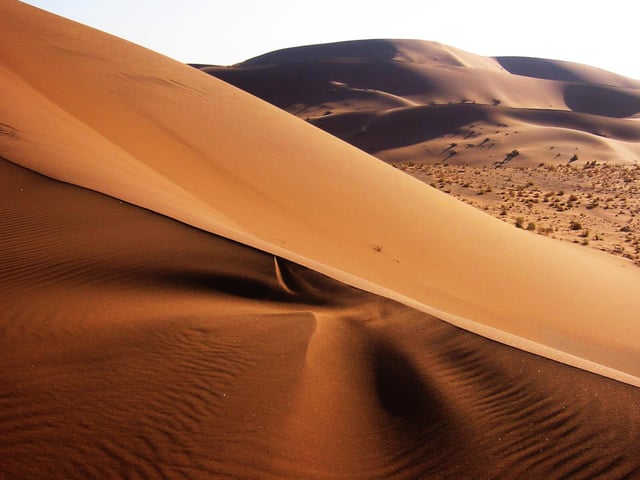
Sand dunes in the Namib, Namibia
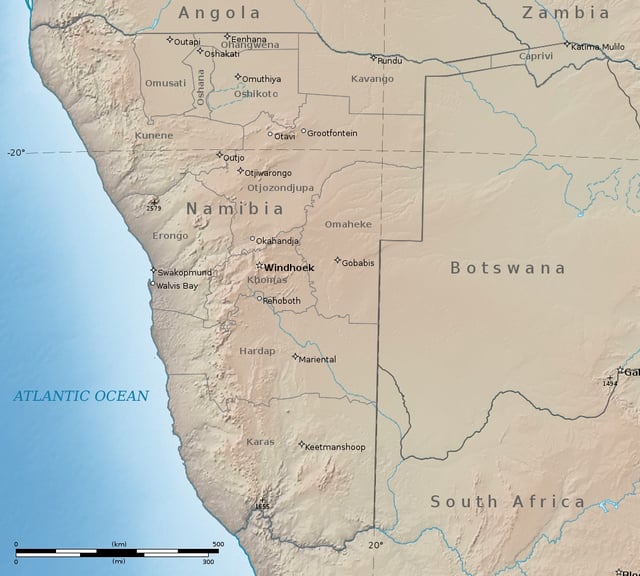
Shaded relief map of Namibia

Namibia map of Köppen climate classification zones
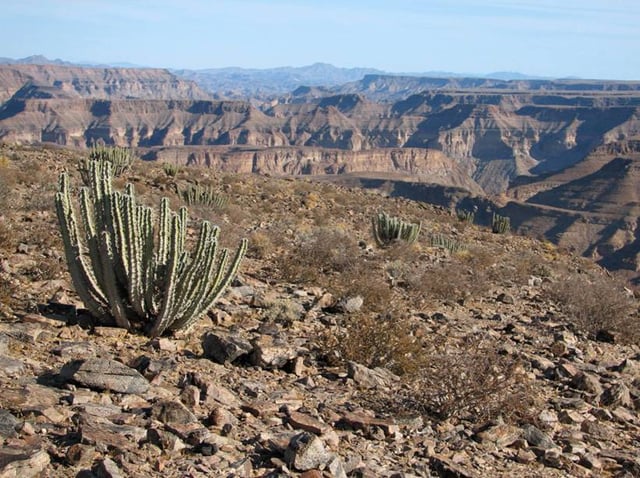
Fish River Canyon
At 825,615 km2 (318,772 sq mi),[56] Namibia is the world's thirty-fourth largest country (after Venezuela). It lies mostly between latitudes 17° and 29°S (a small area is north of 17°), and longitudes 11° and 26°E.
Being situated between the Namib and the Kalahari deserts, Namibia has the least rainfall of any country in sub-Saharan Africa.[57]
The Namibian landscape consists generally of five geographical areas, each with characteristic abiotic conditions and vegetation, with some variation within and overlap between them: the Central Plateau, the Namib, the Great Escarpment, the Bushveld, and the Kalahari Desert.
The Central Plateau runs from north to south, bordered by the Skeleton Coast to the northwest, the Namib Desert and its coastal plains to the southwest, the Orange River to the south, and the Kalahari Desert to the east. The Central Plateau is home to the highest point in Namibia at Königstein elevation 2,606 metres (8,550 ft).[58]
The Namib is a broad expanse of hyper-arid gravel plains and dunes that stretches along Namibia's entire coastline. It varies between 100 km (60 miles) and many hundreds in width. Areas within the Namib include the Skeleton Coast and the Kaokoveld in the north and the extensive Namib Sand Sea along the central coast.[18]
The Great Escarpment swiftly rises to over 2,000 metres (7,000 ft). Average temperatures and temperature ranges increase further inland from the cold Atlantic waters, while the lingering coastal fogs slowly diminish. Although the area is rocky with poorly developed soils, it is significantly more productive than the Namib Desert. As summer winds are forced over the Escarpment, moisture is extracted as precipitation.[59]
The Bushveld is found in north-eastern Namibia along the Angolan border and in the Caprivi Strip. The area receives a significantly greater amount of precipitation than the rest of the country, averaging around 400 mm (16 in) per year. The area is generally flat and the soils sandy, limiting their ability to retain water and support agriculture.[60]
The Kalahari Desert, an arid region that extends into South Africa and Botswana, is one of Namibia's well-known geographical features. The Kalahari, while popularly known as a desert, has a variety of localised environments, including some verdant and technically non-desert areas. The Succulent Karoo is home to over 5,000 species of plants, nearly half of them endemic; approximately 10 percent of the world's succulents are found in the Karoo.[61] The reason behind this high productivity and endemism may be the relatively stable nature of precipitation.[62]
Namibia's Coastal Desert is one of the oldest deserts in the world. Its sand dunes, created by the strong onshore winds, are the highest in the world.[63] Because of the location of the shoreline, at the point where the Atlantic's cold water reaches Africa's hot climate, often extremely dense fog forms along the coast.[64] Near the coast there are areas where the dunes are vegetated with hammocks.[65] Namibia has rich coastal and marine resources that remain largely unexplored.[66]
Climate
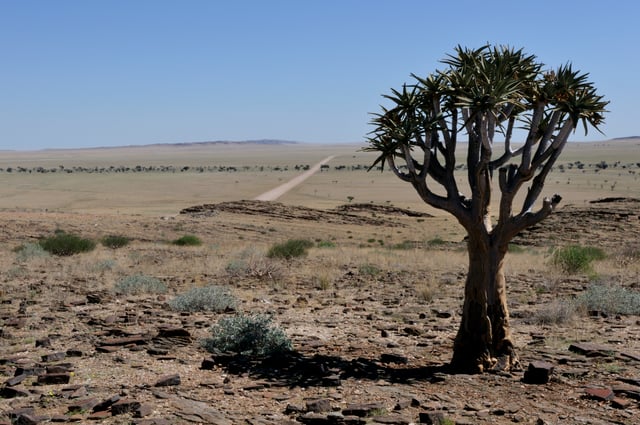
Namibia is primarily a large desert and semi-desert plateau.
Namibia extends from 17°S to 25°S latitude: climatically the range of the sub-Tropical High Pressure Belt. Its overall climate description is arid, descending from the Sub-Humid [mean rain above 500 mm (20 in)] through Semi-Arid [between 300 and 500 mm (12 and 20 in)] (embracing most of the waterless Kalahari) and Arid [from 150 to 300 mm (6 to 12 in)] (these three regions are inland from the western escarpment) to the Hyper-Arid coastal plain [less than 100 mm (4 in)]. Temperature maxima are limited by the overall elevation of the entire region: only in the far south, Warmbad for instance, are mid-40 °C (100 °F) maxima recorded.[67]
Typically the sub-Tropical High Pressure Belt, with frequent clear skies, provides more than 300 days of sunshine per year. It is situated at the southern edge of the tropics; the Tropic of Capricorn cuts the country about in half. The winter (June – August) is generally dry. Both rainy seasons occur in summer: the small rainy season between September and November, the big one between February and April.[68] Humidity is low, and average rainfall varies from almost zero in the coastal desert to more than 600 mm (24 in) in the Caprivi Strip. Rainfall is highly variable, and droughts are common.[69] The last rainy season with rainfall far below the annual average occurred in summer 2006/07.[70]
Weather and climate in the coastal area are dominated by the cold, north-flowing Benguela Current of the Atlantic Ocean, which accounts for very low precipitation (50 mm (2 in) per year or less), frequent dense fog, and overall lower temperatures than in the rest of the country.[69] In Winter, occasionally a condition known as Bergwind (German for "mountain breeze") or Oosweer (Afrikaans for "east weather") occurs, a hot dry wind blowing from the inland to the coast. As the area behind the coast is a desert, these winds can develop into sand storms, leaving sand deposits in the Atlantic Ocean that are visible on satellite images.[71]
The Central Plateau and Kalahari areas have wide diurnal temperature ranges of up to 30 °C (86 °F).[69]
Efundja, the annual seasonal flooding of the northern parts of the country, often causes not only damage to infrastructure but loss of life.[72] The rains that cause these floods originate in Angola, flow into Namibia's Cuvelai basin, and fill the oshanas (Oshiwambo: flood plains) there. The worst floods so far occurred in March 2011 and displaced 21,000 people.[73]
Water sources
Namibia is the driest country in sub-Saharan Africa and depends largely on groundwater. With an average rainfall of about 350 mm (14 in) per annum, the highest rainfall occurs in the Caprivi in the northeast (about 600 mm (24 in) per annum) and decreases in a westerly and southwesterly direction to as little as 50 mm (2 in) and less per annum at the coast. The only perennial rivers are found on the national borders with South Africa, Angola, Zambia, and the short border with Botswana in the Caprivi. In the interior of the country, surface water is available only in the summer months when rivers are in flood after exceptional rainfalls. Otherwise, surface water is restricted to a few large storage dams retaining and damming up these seasonal floods and their runoff. Where people do not live near perennial rivers or make use of the storage dams, they are dependent on groundwater. Even isolated communities and those economic activities located far from good surface water sources, such as mining, agriculture, and tourism, can be supplied from groundwater over nearly 80% of the country.[74]
More than 100,000 boreholes have been drilled in Namibia over the past century. One third of these boreholes have been drilled dry.[75] An aquifer called Ohangwena II, on both sides of the Angola-Namibia border, was discovered in 2012. It has been estimated to be capable of supplying the 800,000 people in the North for 400 years, at the current (2018) rate of consumption.[76] Experts estimate that Namibia has 7,720 km3 (1,850 cu mi) of underground water.[77][78]
Communal Wildlife Conservancies
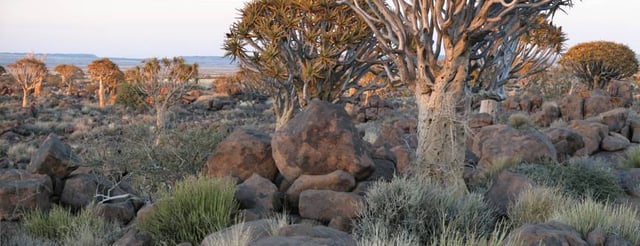
Quivertree Forest, Bushveld
Namibia is one of few countries in the world to specifically address conservation and protection of natural resources in its constitution.[79] Article 95 states, "The State shall actively promote and maintain the welfare of the people by adopting international policies aimed at the following: maintenance of ecosystems, essential ecological processes, and biological diversity of Namibia, and utilisation of living natural resources on a sustainable basis for the benefit of all Namibians, both present and future."[79]
In 1993, Namibia's newly formed government received funding from the United States Agency for International Development (USAID) through its Living in a Finite Environment (LIFE) Project.[80] The Ministry of Environment and Tourism, with financial support from organisations such as USAID, Endangered Wildlife Trust, WWF, and Canadian Ambassador's Fund, together form a Community Based Natural Resource Management (CBNRM) support structure. The project's main goal is to promote sustainable natural resource management by giving local communities rights to wildlife management and tourism.[81]
Politics and government
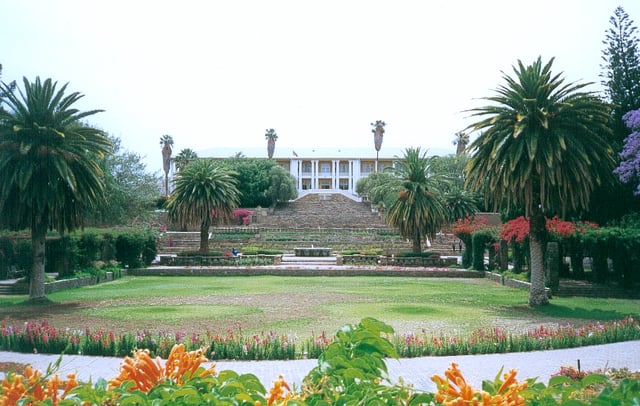
Tintenpalast, the centre of Namibia's government
Namibia is a unitary semi-presidential representative democratic republic.[9][10] The President of Namibia is elected to a five-year term and is both the head of state and the head of government.[82] All members of the government are individually and collectively responsible to the legislature.[83][84]
The Constitution of Namibia guarantees the separation of powers:[85]
Executive: Executive power is exercised by the President and the Government.
Legislature: Namibia has a bicameral Parliament with the National Assembly as lower house, and the National Council as the upper house.[86]
Judiciary: Namibia has a system of courts that interpret and apply the law in the name of the state.
While the constitution envisaged a multi-party system for Namibia's government, the SWAPO party has been dominant since independence in 1990.[87]
Foreign relations
Namibia has a largely independent foreign policy, with persisting affiliations with states that aided the independence struggle, including Cuba. With a small army and a fragile economy, the Namibian government's principal foreign policy concern is developing strengthened ties within the Southern African region. A dynamic member of the Southern African Development Community, Namibia is a vocal advocate for greater regional integration. It became the 160th member of the UN on 23 April 1990. On its independence it became the 50th member of the Commonwealth of Nations.[88]
Military
Namibia does not have any enemies in the region, though it has been involved in various disputes regarding borders and construction plans.[89] It consistently spends more as a percentage of GDP on its military than all of its neighbours except Angola. Military expenditure rose from 2.7% of GDP in 2000 to 3.7% in 2009, and the arrival of 12 Chengdu J-7 Airguard jets in 2006 and 2008 made Namibia for a short time one of the top arms importers in Sub-Saharan Africa.[90] By 2015 military expenditure was estimated at between 4% and 5% of GDP.[91][92][93]
The Namibian constitution defines the role of the military as "defending the territory and national interests." Namibia formed the Namibian Defence Force (NDF), comprising former enemies in a 23-year bush war: the People's Liberation Army of Namibia (PLAN) and South West African Territorial Force (SWATF). The British formulated the plan for integrating these forces and began training the NDF, which consists of a small headquarters and five battalions.
The United Nations Transitional Assistance Group (UNTAG)'s Kenyan infantry battalion remained in Namibia for three months after independence to help train the NDF and to stabilise the north. According to the Namibian Defence Ministry, enlistments of both men and women will number no more than 7,500. The minister of the Namibian Military is Hon Penda YaNdakolo.
In 2017, Namibia signed the UN treaty on the Prohibition of Nuclear Weapons.[94]
Administrative divisions

Regions of Namibia: 1. Kunene 2. Omusati 3. Oshana 4. Ohangwena 5. Oshikoto 6. Kavango West 7. Kavango East 8. Zambezi 9. Erongo 10. Otjozondjupa 11. Omaheke 12. Khomas 13. Hardap 14. ǁKaras
Namibia is divided into 14 regions and subdivided into 121 constituencies. The administrative division of Namibia is tabled by Delimitation Commissions and accepted or declined by the National Assembly. Since state foundation four Delimitation Commissions have delivered their work, the last one in 2013 under the chairmanship of Judge Alfred Siboleka.[95]
Regional councillors are directly elected through secret ballots (regional elections) by the inhabitants of their constituencies.[96]
Local authorities in Namibia can be in the form of municipalities (either Part 1 or Part 2 municipalities), town councils or villages.[97]
Human rights
Homosexual acts are illegal in Namibia[98] and discrimination against LGBT people is still widespread.[99]
In November 2018, it was reported that 32% of women aged 15–49 have experienced violence from their spouse and 29.5% of men believe physical abuse towards their wife is acceptable.[100]
Economy
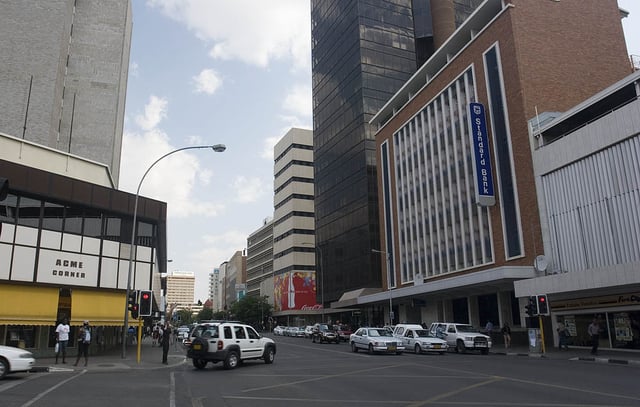
Downtown Windhoek
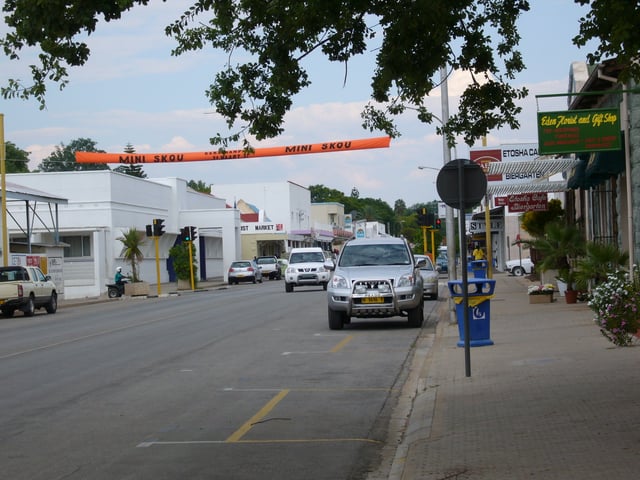
Tsumeb's main road
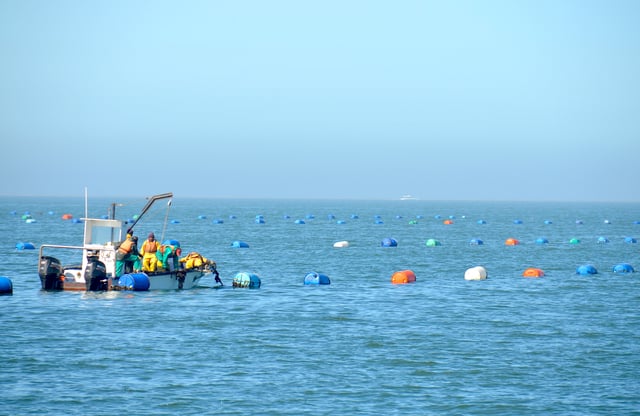
Oysters are cultivated for export at Walvis Bay
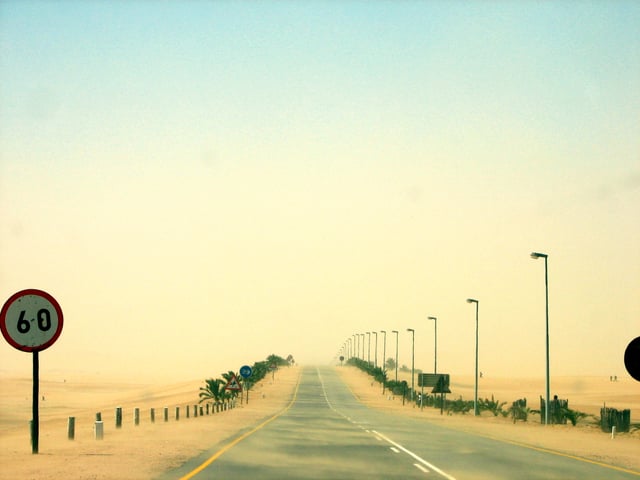
The B2 between Swakopmund and Walvis Bay, Namibia
Namibia has a highly developed banking sector with modern infrastructure, such as online banking and cellphone banking. The Bank of Namibia (BoN) is the central bank of Namibia responsible for performing all other functions ordinarily performed by a central bank. There are 5 BoN authorised commercial banks in Namibia: Bank Windhoek, First National Bank, Nedbank, Standard Bank and Small and Medium Enterprises Bank.[104]
According to the Namibia Labour Force Survey Report 2012, conducted by the Namibia Statistics Agency, the country's unemployment rate is 27.4%.[105] "Strict unemployment" (people actively seeking a full-time job) stood at 20.2% in 2000, 21.9% in 2004 and spiraled to 29.4% in 2008. Under a broader definition (including people that have given up searching for employment) unemployment rose to 36.7% in 2004. This estimate considers people in the informal economy as employed. Labour and Social Welfare Minister Immanuel Ngatjizeko praised the 2008 study as "by far superior in scope and quality to any that has been available previously",[106] but its methodology has also received criticism.[107]
In 2004 a labour act was passed to protect people from job discrimination stemming from pregnancy and HIV/AIDS status. In early 2010 the Government tender board announced that "henceforth 100 per cent of all unskilled and semi-skilled labour must be sourced, without exception, from within Namibia".[108]
In 2013, global business and financial news provider, Bloomberg, named Namibia the top emerging market economy in Africa and the 13th best in the world. Only four African countries made the Top 20 Emerging Markets list in the March 2013 issue of Bloomberg Markets magazine, and Namibia was rated ahead of Morocco (19th), South Africa (15th) and Zambia (14th). Worldwide, Namibia also fared better than Hungary, Brazil and Mexico. Bloomberg Markets magazine ranked the top 20 based on more than a dozen criteria. The data came from Bloomberg's own financial-market statistics, IMF forecasts and the World Bank. The countries were also rated on areas of particular interest to foreign investors: the ease of doing business, the perceived level of corruption and economic freedom. In order to attract foreign investment, the government has made improvement in reducing red tape resulted from excessive government regulations, making Namibia one of the least bureaucratic places to do business in the region. Facilitation payments are occasionally demanded by customs due to cumbersome and costly customs procedures.[109] Namibia is also classified as an Upper Middle Income country by the World Bank, and ranks 87th out of 185 economies in terms of ease of doing business.[110]
The cost of living in Namibia is relatively high because most goods, including cereals, need to be imported. Its capital city, Windhoek, is the 150th most expensive place in the world for expatriates to live.[111]
Taxation in Namibia includes personal income tax, which is applicable to total taxable income of an individual. All individuals are taxed at progressive marginal rates over a series of income brackets. The value added tax (VAT) is applicable to most of the commodities and services.[112]
Despite the remote nature of much of the country, Namibia has seaports, airports, highways, and railways (narrow-gauge). It seeks to become a regional transportation hub; it has an important seaport and several landlocked neighbours. The Central Plateau already serves as a transportation corridor from the more densely populated north to South Africa, the source of four-fifths of Namibia's imports.[113]
Income disparity
According to recent statistics on the country's income share held by the highest 10%, Namibia is a country with a substantive income disparity. The data indicates that the current income share held by the highest 10% is approximately 51.8%. This disparity illustrates the large gap between the rich and the poor. An additional figure describes the poverty gap: people living on US$2 or less in the country are approximately 17.72% of the population.
Agriculture
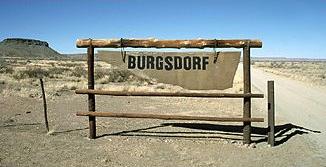
Welcoming sign of the Burgsdorf farm in Hardap
About half of the population depends on agriculture (largely subsistence agriculture) for its livelihood, but Namibia must still import some of its food. Although per capita GDP is five times the per capita GDP of Africa's poorest countries, the majority of Namibia's people live in rural areas and have a subsistence way of life. Namibia has one of the highest rates of income inequality in the world, due in part to the fact that there is an urban economy and a more rural cashless economy. The inequality figures thus take into account people who do not actually rely on the formal economy for their survival. Although arable land accounts for only 1% of Namibia, nearly half of the population is employed in agriculture.[113]
Agreement has been reached on the privatisation of several more enterprises in coming years, with hopes that this will stimulate much needed foreign investment, but reinvestment of environmentally derived capital has hobbled Namibian per capita income.[116] One of the fastest growing areas of economic development in Namibia is the growth of wildlife conservancies. These are particularly important to the rural, generally unemployed, population.
Mining and electricity
Providing 25% of Namibia's revenue, mining is the single most important contributor to the economy.[117] Namibia is the fourth largest exporter of non-fuel minerals in Africa and the world's fourth largest producer of uranium. There has been significant investment in uranium mining and Namibia is set to become the largest exporter of uranium by 2015.[118] Rich alluvial diamond deposits make Namibia a primary source for gem-quality diamonds.[119] While Namibia is known predominantly for its gem diamond and uranium deposits, a number of other minerals are extracted industrially such as lead, tungsten, gold, tin, fluorspar, manganese, marble, copper and zinc. There are offshore gas deposits in the Atlantic Ocean that are planned to be extracted in the future.[103] According to "The Diamond Investigation", a book about the global diamond market, from 1978, De Beers, the largest diamond company, bought most of the Namibian diamonds, and would continue to do so, because "whatever government eventually comes to power they will need this revenue to survive".[120]
Domestic supply voltage is 220 V AC. Electricity is generated mainly by thermal and hydroelectric power plants. Non-conventional methods of electricity generation also play some role. Encouraged by the rich uranium deposits the Namibian government plans to erect its first nuclear power station by 2018, also uranium enrichment is envisaged to happen locally.[121]
Diamonds
Although much of the world's diamond supply comes from what have been called African blood diamonds, Namibia has managed to develop a diamond mining industry largely free of the kinds of conflict, extortion, and murder that have plagued many other African nations with diamond mines. This has been attributed to political dynamics, economic institutions, grievances, political geography, and the effects of neighbourhoods, and is the result of a joint agreement between the government and De Beers that has led to a taxable base, strengthening state institutions.[122]
Tourism
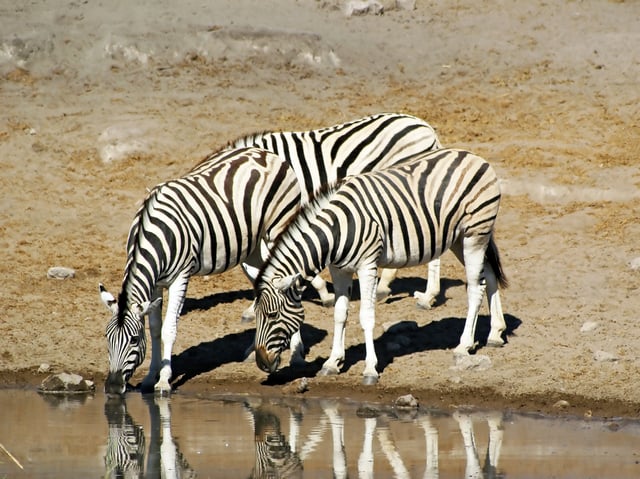
An example of Namibian wildlife, the plains zebra, is one focus of tourism.
Tourism is a major contributor (14.5%) to Namibia's GDP, creating tens of thousands of jobs (18.2% of all employment) directly or indirectly and servicing over a million tourists per year.[123] The country is a prime destination in Africa and is known for ecotourism, which features Namibia's extensive wildlife.[124]
There are many lodges and reserves to accommodate eco-tourists. Sport and trophy hunting is also a large and growing component of the Namibian economy, accounting for 14% of total tourism in the year 2000, or 19.6 million US dollars, with Namibia boasting numerous species sought after by international sport hunters.[125]
In addition, extreme sports such as sandboarding, skydiving and 4x4ing have become popular, and many cities have companies that provide tours. The most visited places include the capital city of Windhoek, Caprivi Strip, Fish River Canyon, Sossusvlei, the Skeleton Coast Park, Sesriem, Etosha Pan and the coastal towns of Swakopmund, Walvis Bay and Lüderitz.[126]
Windhoek plays a very important role in Namibia's tourism due to its central location and close proximity to Hosea Kutako International Airport. According to The Namibia Tourism Exit Survey, which was produced by the Millennium Challenge Corporation for the Namibian Directorate of Tourism, 56% of all tourists visiting Namibia in 2012–13 visited Windhoek.[127] Many of Namibia's tourism related parastatals and governing bodies such as Namibia Wildlife Resorts, Air Namibia and the Namibia Tourism Board as well as Namibia's tourism related trade associations such as the Hospitality Association of Namibia are headquartered in Windhoek.[128] There are also a number of notable hotels in Windhoek, such as Windhoek Country Club Resort, and some international hotel chains, such as Avani Hotels and Resorts and Hilton Hotels and Resorts.
Namibia's primary tourism related governing body, the Namibia Tourism Board (NTB), was established by an Act of Parliament: the Namibia Tourism Board Act, 2000 (Act 21 of 2000). Its primary objectives are to regulate the tourism industry and to market Namibia as a tourist destination.[129] There are also a number of trade associations that represent the tourism sector in Namibia, such as the Federation of Namibia Tourism Associations (the umbrella body for all tourism associations in Namibia), the Hospitality Association of Namibia, the Association of Namibian Travel Agents, Car Rental Association of Namibia and the Tour and Safari Association of Namibia.[130]
Water supply and sanitation
Namibia is the only country in Sub-Saharan Africa to provide water through municipal departments.[131] The only bulk water supplier in Namibia is NamWater, which sells it to the respective municipalities which in turn deliver it through their reticulation networks.[131] In rural areas, the Directorate of Rural Water Supply in the Ministry of Agriculture, Water and Forestry is in charge of drinking water supply.[131]
The UN evaluated in 2011 that Namibia has improved its water access network significantly since independence in 1990. A large part of the population can not, however, make use of these resources due to the prohibitively high consumption cost and the long distance between residences and water points in rural areas.[131] As a result, many Namibians prefer the traditional wells over the available water points far away.[132]
Compared to the efforts made to improve access to safe water, Namibia is lagging behind in the provision of adequate sanitation.[133] This includes 298 schools that have no toilet facilities.[134] Over 50% of child deaths are related to lack of water, sanitation, or hygiene; 23% are due to diarrhea alone. The UN has identified a "sanitation crisis" in the country.[132]
Apart from residences for upper and middle class households, sanitation is insufficient in most residential areas. Private flush toilets are too expensive for virtually all residents in townships due to their water consumption and installation cost. As a result, access to improved sanitation has not increased much since independence: in Namibia's rural areas 13% of the population had more than basic sanitation, up from 8% in 1990. Many of Namibia's inhabitants have to resort to "flying toilets", plastic bags to defecate into, which after use are flung into the bush.[135] The use of open areas close to residential land for urination and defecation is very common[136] and has been identified as a major health hazard.[134]
Demographics

Population density in Namibia by regions (census 2011)
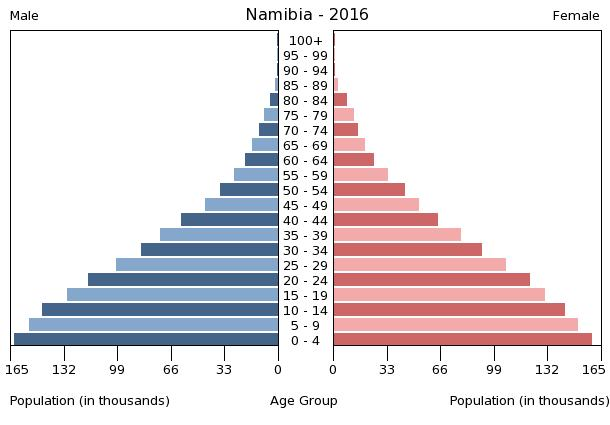
Population pyramid 2016
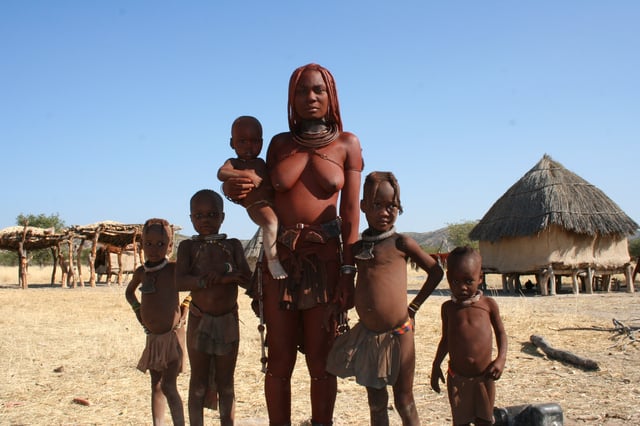
Himba people in northern Namibia

Children in Namibia
| Population[137] | |||
|---|---|---|---|
| Year | Million | ||
| 1950 | 0.5 | ||
| 2000 | 1.9 | ||
| 2016 | 2.5 | ||
Namibia has the second-lowest population density of any sovereign country, after Mongolia.[138] In 2017 there were on average 3.08 people per km².[139] The total fertility rate in 2015 was 3.47 children per woman according to the UN.
The majority of the Namibian population is of Bantu-speaking origin—mostly of the Ovambo ethnicity, which forms about half of the population—residing mainly in the north of the country, although many are now resident in towns throughout Namibia. Other ethnic groups are the Herero and Himba people, who speak a similar language, and the Damara, who speak the same "click" language as the Nama.
In addition to the Bantu majority, there are large groups of Khoisan (such as Nama and San), who are descendants of the original inhabitants of Southern Africa. The country also contains some descendants of refugees from Angola. There are also two smaller groups of people with mixed racial origins, called "Coloureds" and "Basters", who together make up 8.0% (with the Coloureds outnumbering the Basters two to one). There is a substantial Chinese minority in Namibia; it stood at 40,000 in 2006.[140]
Whites (mainly of Afrikaner, German, British and Portuguese origin) make up between 4.0 and 7.0% of the population. Although their proportion of the population decreased after independence due to emigration and lower birth rates, they still form the second-largest population of European ancestry, both in terms of percentage and actual numbers, in Sub-Saharan Africa (after South Africa).[141] The majority of Namibian whites and nearly all those who are mixed race speak Afrikaans and share similar origins, culture, and religion as the white and coloured populations of South Africa. A large minority of whites (around 30,000) trace their family origins back to the German settlers who colonized Namibia prior to the British confiscation of German lands after World War I, and they maintain German cultural and educational institutions. Nearly all Portuguese settlers came to the country from the former Portuguese colony of Angola.[142] The 1960 census reported 526,004 persons in what was then South West Africa, including 73,464 whites (14%).[143]
Namibia conducts a census every ten years. After independence the first Population and Housing Census was carried out in 1991; further rounds followed in 2001 and 2011.[144] The data collection method is to count every person resident in Namibia on the census reference night, wherever they happen to be. This is called the de facto method.[145] For enumeration purposes the country is demarcated into 4,042 enumeration areas. These areas do not overlap with constituency boundaries to get reliable data for election purposes as well.[146]
The 2011 Population and Housing Census counted 2,113,077 inhabitants. Between 2001 and 2011 the annual population growth was 1.4%, down from 2.6% in the previous ten-year period.[147]
Religion
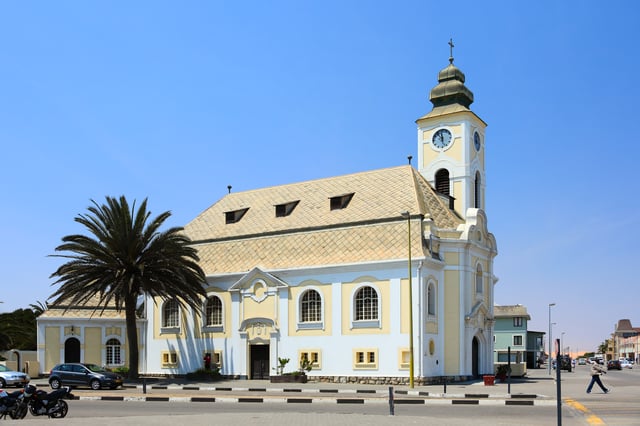
Lutheran church in Swakopmund
The Christian community makes up 80%–90% of the population of Namibia, with at least 75% being Protestant, and at least 50% Lutheran. Lutherans are the largest religious group, a legacy of the German and Finnish missionary work during the country's colonial times. 10%–20% of the population hold indigenous beliefs.[141]
Missionary activities during the second half of the 19th century resulted in many Namibians converting to Christianity. Today most Christians are Lutheran, but there also are Roman Catholic, Methodist, Anglican, African Methodist Episcopal, Dutch Reformed and Mormons (The Church of Jesus Christ of Latter-day Saints).
Languages
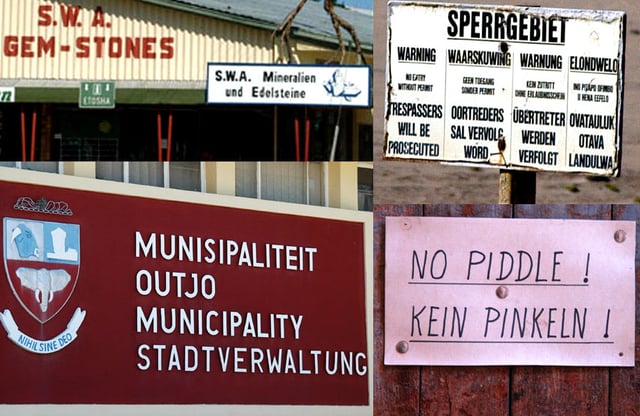
Although its official language is English, Namibia is a multilingual country as is illustrated by these examples in English, German, Afrikaans and Oshiwambo.
Up to 1990, English, German, and Afrikaans were official languages. Long before Namibia's independence from South Africa, SWAPO was of the opinion that the country should become officially monolingual, choosing this approach in contrast to that of its neighbour South Africa (which granted all 11 of its major languages official status), which it saw as "a deliberate policy of ethnolinguistic fragmentation."[151] Consequently, SWAPO instituted English as Namibia's sole official language though only about 3% of the population speaks it as a home language. Its implementation is focused on the civil service, education and the broadcasting system, especially the state broadcaster NBC.[152] Some other languages have received semi-official recognition by being allowed as medium of instruction in primary schools. Private schools are expected to follow the same policy as state schools, and "English language" is a compulsory subject.[152] Some critics argue that, as in other postcolonial African societies, the push for monolingual instruction and policy has resulted in a high rate of school dropouts and of individuals whose academic competence in any language is low.[153]
According to the 2011 census, the most common languages are Oshiwambo (the most spoken language for 49% of households),[154] Nama/Damara (11.3%), Afrikaans (10.4%), Kavango (9%), and Otjiherero (9%).[147][155] The most widely understood national language is Afrikaans, the country's lingua franca. Both Afrikaans and English are used primarily as a second language reserved for public communication. A complete list of languages according to the 2011 census is 48.9% Oshiwambo, 11.3% Nama/Damara, 10.4% Afrikaans, 8.6% Otjiherero, 8.5% Kavango, 4.8% Caprivi Languages, 3.4% English, 1.2% Other African Languages, 0.9% German, 0.8% San, 0.7% Other European Languages, 0.3% Setswana, and 0.1% Asian Languages.[156]
Most of the white population speaks either German or Afrikaans. Even today, 104 years after the end of the German colonial era, German plays a role as a commercial language. Afrikaans is spoken by 60% of the white community, German by 32%, English by 7% and Portuguese by 4–5%.[141] Geographical proximity to Portuguese-speaking Angola explains the relatively high number of Portuguese speakers; in 2011 these were estimated to be 100,000, or 4–5% of the total population.[157]
Largest cities
Sport
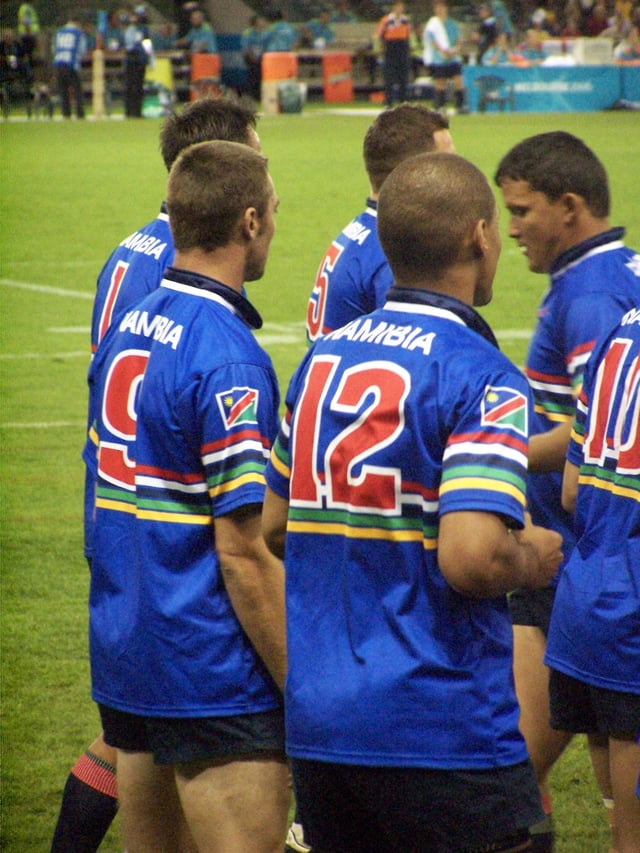
The Namibia rugby team
The most popular sport in Namibia is association football. The Namibia national football team qualified for the 1998, 2008 and 2019 editions of the Africa Cup of Nations, but has yet to qualify for the World Cup.
The most successful national team is the Namibian rugby team, having competed in five separate World Cups. Namibia were participants in the 1999, 2003, 2007, 2011 and 2015 Rugby World Cups. Cricket is also popular, with the national side having played in the 2003 Cricket World Cup. In December 2017, Namibia Cricket reached the final of the Cricket South Africa (CSA) Provincial One Day Challenge for the first time.[159] In February 2018 Namibia hosted the ICC World Cricket League Division 2 with Namibia, Kenya, UAE, Nepal, Canada and Oman to compete for the final two ICC Cricket World Cup Qualifier positions in Zimbabwe.[159]
The most famous athlete from Namibia is Frankie Fredericks, sprinter in the 100 and 200 m events. He won four Olympic silver medals (1992, 1996) and also has medals from several World Athletics Championships.[160] Golfer Trevor Dodds won the Greater Greensboro Open in 1998, one of 15 tournaments in his career. He achieved a career high world ranking of 78th in 1998. Professional cyclist and Namibian Road Race champion Dan Craven represented Namibia at the 2016 Summer Olympics in both the road race and individual time trial. Boxer Julius Indongo is the unified WBA, IBF, and IBO world champion in the Light welterweight division.
Media
Although Namibia's population is fairly small, the country has a diverse choice of media; two TV stations, 19 radio stations (without counting community stations), 5 daily newspapers, several weeklies and special publications compete for the attention of the audience. Additionally, a mentionable amount of foreign media, especially South African, is available. Online media are mostly based on print publication contents. Namibia has a state-owned Press Agency, called NAMPA.[161] Overall c. 300 journalists work in the country.[162]
The first newspaper in Namibia was the German-language Windhoeker Anzeiger, founded 1898. During German rule, the newspapers mainly reflected the living reality and the view of the white German-speaking minority. The black majority was ignored or depicted as a threat. During South African rule, the white bias continued, with mentionable influence of the Pretoria government on the "South West African" media system. Independent newspapers were seen as a menace to the existing order, and critical journalists were often threatened.[161][163][164]
Current daily newspapers are the private publications The Namibian (English and other languages), Die Republikein (Afrikaans), Allgemeine Zeitung (German) and Namibian Sun (English) as well as the state-owned New Era (predominantly English). Except for the largest newspaper, The Namibian, which is owned by a trust, the other mentioned private newspapers are part of the Democratic Media Holdings.[161] Other mentionable newspapers are the tabloid Informanté owned by TrustCo, the weekly Windhoek Observer, the weekly Namibia Economist, as well as the regional Namib Times. Current affairs magazines include Insight Namibia, Vision2030 Focus magazine and Prime FOCUS. The Sister Namibia magazine stands out as the longest running NGO magazine in Namibia, while Namibia Sport is the only national sport magazine. Furthermore, the print market is complemented with party publications, student newspapers and PR publications.[161]
Radio was introduced in 1969, TV in 1981. The broadcasting sector today is dominated by the state-run Namibian Broadcasting Corporation (NBC). The public broadcaster offers a TV station as well as a "National Radio" in English and nine language services in locally spoken languages. The nine private radio stations in the country are mainly English-language channels, except for Radio Omulunga (Oshiwambo) and Kosmos 94.1 (Afrikaans). Privately held One Africa TV has competed with NBC since the 2000s.[161][165]
Compared to neighbouring countries, Namibia has a large degree of media freedom. Over the past years, the country usually ranked in the upper quarter of the Press Freedom Index of Reporters without Borders, reaching position 21 in 2010, being on par with Canada and the best-positioned African country.[166] The African Media Barometer shows similarly positive results. However, as in other countries, there is still mentionable influence of representatives of state and economy on media in Namibia.[161] In 2009, Namibia dropped to position 36 on the Press Freedom Index.[167] In 2013, it was 19th.[168] In 2014 it ranked 22nd [169]
Media and journalists in Namibia are represented by the Namibian chapter of the Media Institute of Southern Africa and the Editors' Forum of Namibia. An independent media ombudsman was appointed in 2009 to prevent a state-controlled media council.[161]
Education
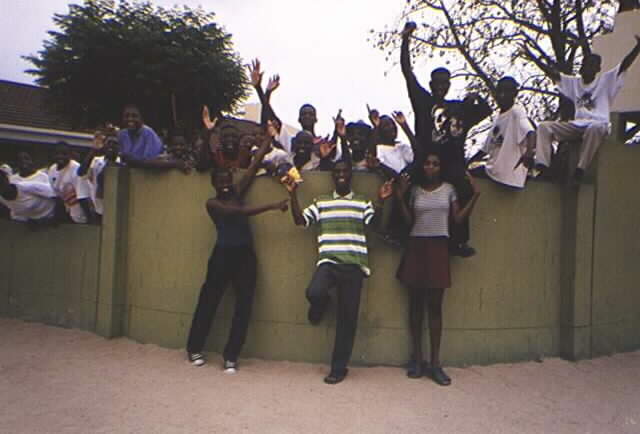
Secondary school students
Namibia has free education for both primary and secondary education levels. Grades 1–7 are primary level, grades 8–12 are secondary. In 1998, there were 400,325 Namibian students in primary school and 115,237 students in secondary schools. The pupil-teacher ratio in 1999 was estimated at 32:1, with about 8% of the GDP being spent on education.[170] Curriculum development, educational research, and professional development of teachers is centrally organised by the National Institute for Educational Development (NIED) in Okahandja.[171]
Most schools in Namibia are state-run, but there are some private schools, which are also part of the country's education system. There are four teacher training universities, three colleges of agriculture, a police training college, and three universities: University of Namibia (UNAM), International University of Management (IUM) and Namibia University of Science and Technology (NUST).
Health

Estimated percentage of HIV among young adults (15–49) per country as of 2011.[176] 15–50
Life expectancy at birth is estimated to be 64 years in 2017 – among the lowest in the world.[172]
Namibia launched a National Health Extension Programme in 2012[173] deployment 1,800 (2015) of a total ceiling of 4,800 health extension workers trained for six months in community health activities including first aid, health promotion for disease prevention, nutritional assessment and counseling, water sanitation and hygiene practices, HIV testing and community-based antiretroviral treatment.[174]
Namibia faces non-communicable disease burden. The Demographic and Health Survey (2013) summarizes findings on elevated blood pressure, hypertension, diabetes and obesity:
Among eligible respondents age 35–64, more than 4 in 10 women (44 percent) and men (45 percent) have elevated blood pressure or are currently taking medicine to lower their blood pressure.
Forty-nine percent of women and 61 percent of men are not aware that they have elevated blood pressure.
Forty-three percent of women and 34 percent of men with hypertension are taking medication for their condition.
Only 29 percent of women and 20 percent of men with hypertension are taking medication and have their blood pressure under control.
Six percent of women and 7 percent of men are diabetic; that is, they have elevated fasting plasma glucose values or report that they are taking diabetes medication. An additional 7 percent of women and 6 percent of men are prediabetic.
Sixty-seven percent of women and 74 percent of men with diabetes are taking medication to lower their blood glucose.
Women and men with a higher-than-normal body mass index (25.0 or higher) are more likely to have elevated blood pressure and elevated fasting blood glucose.[175]
The HIV epidemic remains a public health issue in Namibia despite significant achievements made by the Ministry of Health and Social Services to expand HIV treatment services.[177] In 2001, there were an estimated 210,000 people living with HIV/AIDS, and the estimated death toll in 2003 was 16,000. According to the 2011 UNAIDS Report, the epidemic in Namibia "appears to be leveling off."[178] As the HIV/AIDS epidemic has reduced the working-aged population, the number of orphans has increased. It falls to the government to provide education, food, shelter and clothing for these orphans.[179] A Demographic and Health Survey with an HIV biomarker was completed in 2013 [192] and served as the fourth comprehensive, national-level population and health survey conducted in Namibia as part of the global Demographic and Health Surveys (DHS) programme. The DHS observed important characteristics associated to the HIV epidemic:
Overall, 26 percent of men age 15–49 and 32 percent of those age 50–64 have been circumcised. HIV prevalence for men age 15–49 is lower among circumcised (8.0 percent) than among uncircumcised men (11.9 percent). The pattern of lower HIV prevalence among circumcised than uncircumcised men is observed across most background characteristics. For each age group, circumcised men have lower HIV prevalence than those who are not circumcised; the difference is especially pronounced for men age 35–39 and 45–49 (11.7 percentage points each). The difference in HIV prevalence between uncircumcised and circumcised men is larger among urban than rural men (5.2 percentage points versus 2.1 percentage points).
HIV prevalence among respondents age 15–49 is 16.9 percent for women and 10.9 percent for men. HIV prevalence rates among women and men age 50–64 are similar (16.7 percent and 16.0 percent, respectively).
HIV prevalence peaks in the 35–39 age group for both women and men (30.9 percent and 22.6 percent, respectively). It is lowest among respondents age 15–24 (2.5–6.4 percent for women and 2.0–3.4 percent for men).
Among respondents age 15–49, HIV prevalence is highest for women and men in Zambezi (30.9 percent and 15.9 percent, respectively) and lowest for women in Omaheke (6.9 percent) and men in Ohangwena (6.6 percent).
In 76.4 percent of the 1,007 cohabiting couples who were tested for HIV in the 2013 NDHS, both partners were HIV negative; in 10.1 percent of the couples, both partners were HIV positive; and 13.5 percent of the couples were discordant (that is, one partner was infected with HIV and the other was not).[175]
The malaria problem seems to be compounded by the AIDS epidemic.[181] Research has shown that in Namibia the risk of contracting malaria is 14.5% greater if a person is also infected with HIV.[181] The risk of death from malaria is also raised by approximately 50% with a concurrent HIV infection.[182] The country had only 598 physicians in 2002.[183]
See also
Index of Namibia-related articles
Outline of Namibia
